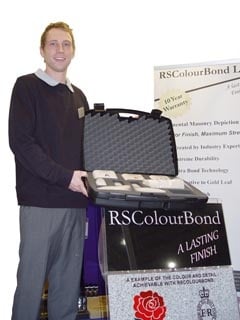There were fewer exhibitors on the memorial masonry side of the National Funeral Exhibition (NFE) in Stoneleigh Park this month (June) than there had been when it was last held, two years ago, but there were new products and ranges to be seen. They included what Odlings MCR say is the first ever dual media pressure pot blasting cabinet and a new memorial stone painting system from a new company called RSColourBond.
Odlings MCR’s new blast cabinet was launched at the Natural Stone Show at ExCeL London in March and was on show again at Stoneleigh among the memorial engraving and handling equipment that they sell.
The benefit of a dual media pressure pot is that it allows the use of two grades of blasting media in the same cabinet. The pots are different sizes, so the larger is used for the normal engraving grit and the other for a finer grit.
Each pot has its own control system, with individual regulators and guns, so the settings on one are not lost when you switch to the other. They are mounted on an indexing plate with micro-switches so you do not inadvertently use the wrong settings.
The only slightly tricky part of the design was doing the maths to avoid having a 1200mm indexing plate, says Ken Evans, the Factory Manager. He says that judging by the number of these blast cabinets being produced in the factory, especially of larger units, they have certainly proved popular.
On their stand at NFE, Odlings MCR also gave demonstrations on a photostencil of the use of their Stonecarve software that can be used to blast even small lettering, human faces and intricate designs.
The new paint system from RSColourBond was launched at Stoneleigh Park with a 10-year guarantee that it will not peel off or fade, which is an indication of the confidence the developers of the paint have in their system – because, being new, there is no 10-year-old test sample to show it does survive.
RSColourBond are an offshoot of Richmond Stonework, who sell commemorative stones, such as those laid into the paving at football and rugby stadiums to record the names of people who have made donations and bequests. The letters are often painted after they have been cut into the stone but the paint wears. So Richmond Stonework set about creating a paint that would survive being walked on.
Having developed it, they have set up the new company to sell it and among their target audiences are memorial masons. James Booth, pictured below on the company’s stand at NFE, is the Managing Director. He told NSS: “Developing it wasn’t simple and it wasn’t cheap.”
And it was not just resilience they wanted, they also wanted vibrant colours, which they have achieved.
The three-part paint system is supplied in a suitcase with all the ingredients and measuring equipment to get the mixes right. It costs £600 and will be sufficient for 100 memorials, they say. It can be used with brushes, sprays or pipets.
They plan to introduce an alternative to lead next that will stand proud of the surface, then mirror and luminous paints.

